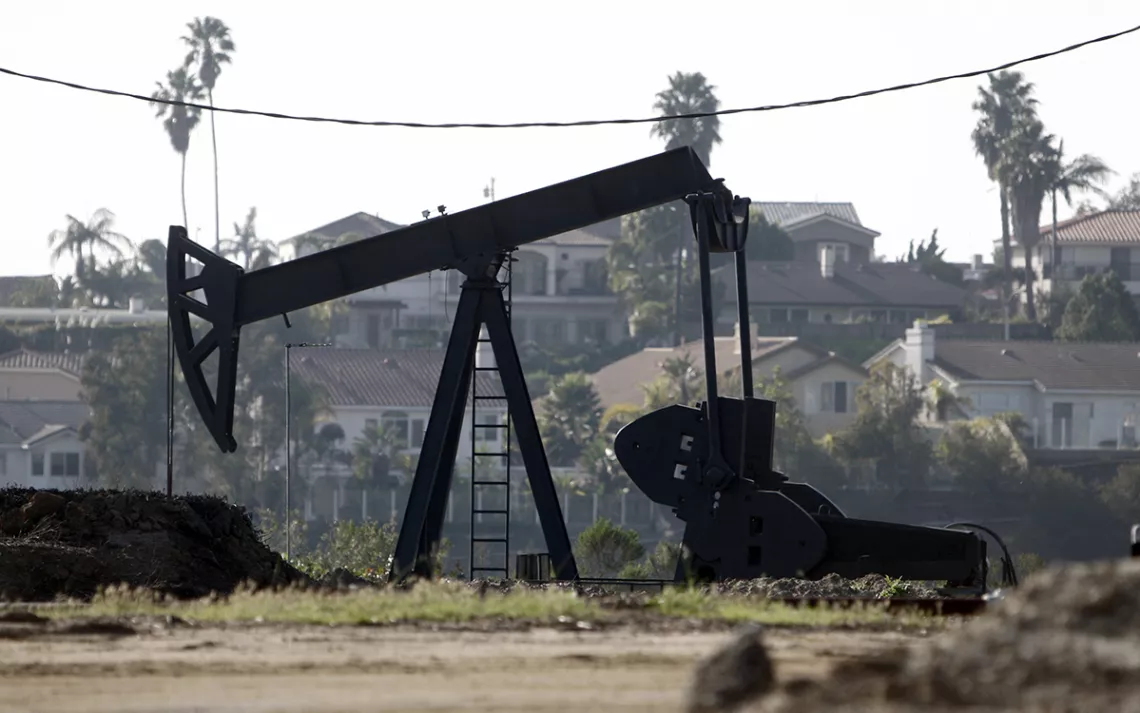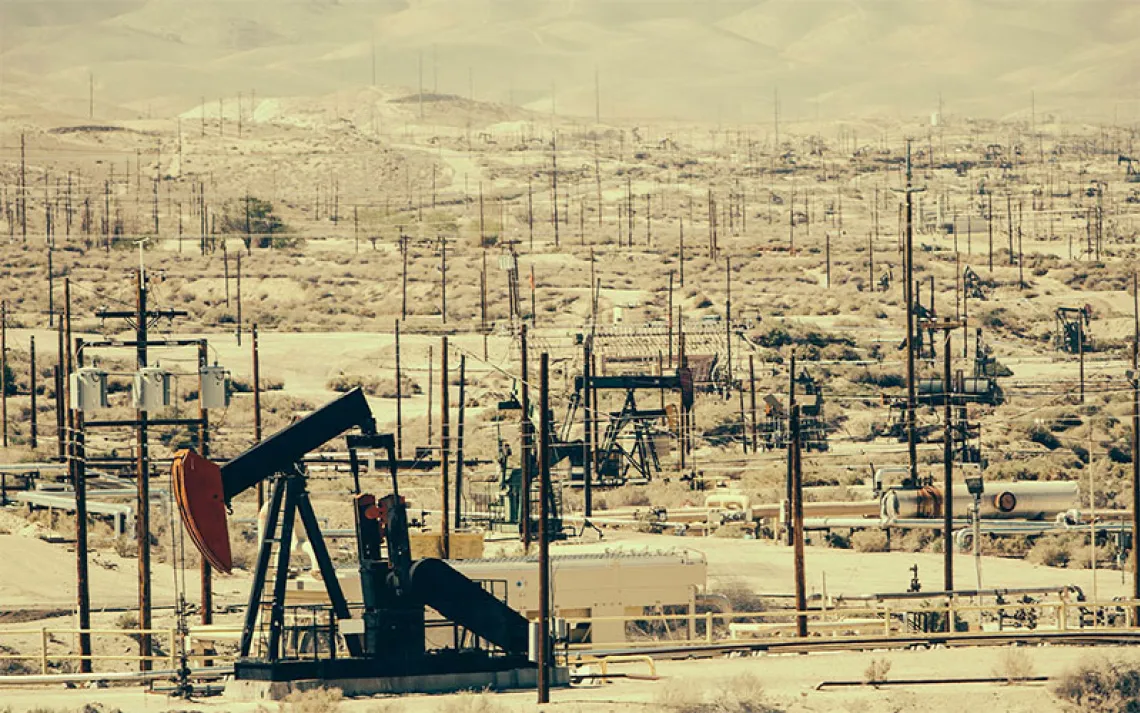Two Cheers for California’s New Oil and Gas Setbacks
New drilling rigs need to be a kilometer away from homes, schools, and hospitals, but old ones stay

Future oil rigs in California will have to be at least 3,200 feet from houses, schools, and hospitals. | Photo by AP Photo/Reed Saxon
The many Californians who live cheek by jowl with oil and gas drilling rigs have waited a long time for their state to protect their health by establishing buffer zones around fossil fuel operations. In the years since Governor Gavin Newsom took office in 2018, legislation to establish such zones has repeatedly popped up in the state legislature only to be knocked back down before an official vote. Deadlines for regulators to act have been set and extended and—seemingly—all but forgotten.
So when in late October the California Geologic Energy Management Division (CalGEM) published a draft “setback exclusion area” for oil and gas operations, it came as a shock, even to those who had been paying close attention. Gustavo Aguirre Jr., Kern County director of the Central California Environmental Justice Network (CCEJN), learned the news the night before the announcement in a text from his brother, Cesar, CCEJN’s oil and gas organizer. “I read it and was like, ‘What? Are you messing with me?’”
Activists were also surprised by the size of the proposed buffer zone—a 3,200-foot radius around homes, schools, and hospitals, all “sensitive receptors” in regulatory parlance. Few jurisdictions have established buffer zones for fossil fuel production so large. Dallas, Texas, which has been cited many times to shame California, has since 2013 required drillers to observe a setback of 1,500 feet from sensitive areas; next door, Fort Worth settled for only 600 feet. Aguirre was impressed. “It was like I stepped away for a minute,” Aguirre said, “and then yeah—3,200 feet? OK. Cool.”
Thirty-two hundred feet, notes Collin Rees, US program director with Oil Change International, is “pretty close to a kilometer, the [setback zone distance] that aligns with international research.” It would have been a useful unit of measure for Governor Newsom, had he gone to Glasgow for the climate talks. (He canceled at the last minute, citing family obligations.)
Another explanation for the timing, says Mercedes Macias, Kern County organizer for the Sierra Club, is Newsom’s recent victory in a recall effort that the oil and gas industry partially bankrolled. “This is almost like his victory move,” she says. “Had the governor not won the recall, we’d be looking at a very different outcome.”
Now that the excitement has worn off a bit, Aguirre and other public health advocates have been looking at the near-term impact of the draft regulation, and how much difference it will make in how oil and gas currently operate in the state of California. The answer appears to be "very little."
“For the folks here in Kern County and Los Angeles that already live right across the street from these sites, it’s still business as usual,” Aguirre says. The draft proposal will only apply to new wells and processing facilities; existing operations can stay where they’re already permitted. “So even though it’s a great move for the future of frontline communities, we’re still asking ourselves, ‘What are we doing now? In this immediate timeframe?'”
The proposed regulations do stipulate that existing drilling near those sensitive receptors will need to employ better air monitoring and pollution-control technology. But Aguirre isn’t persuaded that it will matter. In April, Kern County issued a blanket environmental approval that applies to all wells within the county, an update to a 2015 ordinance that the court rescinded in 2020 after a suit by the Sierra Club and other environmental groups. Last month, an appeals court suspended the revised regulations too, pending judicial review. Aguirre worries that if the court gives the county the go-ahead, Kern’s oil and gas setback rule–so small as to be meaningless—could override the state’s new, more stringent regulations.
The county has acted in a similar fashion before. In the Kern County town of Shafter, a state-ordered emissions reduction plan required farmers to notify residents before deploying certain carcinogenic pesticides. The county was given $250,000 to implement it but has so far refused to comply.
On the new buffer-zone proposal, Aguirre says, “Our residents have been saying, ‘Wait, is it going to be like the pesticide-notification program? Where there’s going to be just an infinite exemption for Kern County?’"
“The community is happy,” he says, “but very confused.”
Macias agrees with Aguirre that more immediate action is needed to protect her community, but even so, she admits to being thrilled by the development. “It’s a victory for us,” she says.
Rees agrees that some celebration is in order. The proposal is a sign that Newsom and his regulators might finally stand up to the state’s influential oil lobby. “It’s increasingly obvious on the climate side of things that we have to be dealing with the supply as well as the demand for fossil fuels.” With CalGEM’s setback proposal as evidence, he says, “I think you’re starting to see that catch on.”
 The Magazine of The Sierra Club
The Magazine of The Sierra Club



